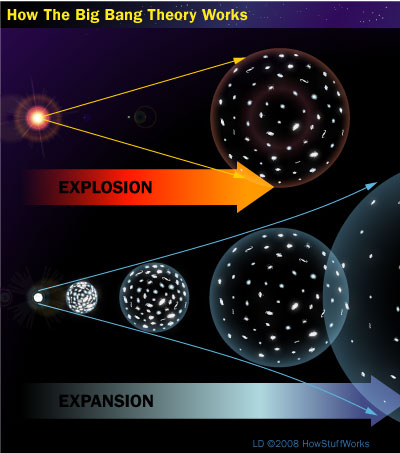
The Big Bang Model is the hypothesis that everything you see exploded or expanded into existence nearly 14 billion years ago. From this big bang model, the universe expanded, evolved, and developed into what you see today.
Actually, Space.com sums up the Big Bang in their article entitled, “Alternatives to the Big Bang Theory Explained” with the following quote:
“Nearly 14 billion years ago, there was nothing and nowhere. Then, due to a random fluctuation in a completely empty void, a universe exploded into existence. Something the size of a subatomic particle inflated to unimaginably huge size in a fraction of a second, driven apart by negative-pressure vacuum energy. Scientists call this theory for the origin of the universe the Big Bang.”
In another article on Space.com entitled, “Images: Peering Back to the Big Bang & Early Universe“, they explain the Big Bang with the following quote:
“The Big Bang theory proposes that the universe began as an extremely hot and dense dot only a few millimeters wide. It since grew over 13.7 billion years into the vast and cooler expanding cosmos that presently exists. An extension of the Big Bang model, inflation, poses that the universe initially expanded far faster than the speed of light and grew from a subatomic size to a golf-ball size almost instantaneously, shown in this diagram.”
But is this true?
Well, it does seem that the big bang model is accurate.
According to Wikopedia: “In 1927, the Belgian Catholic priest Georges Lemaître proposed an expanding model for the universe to explain the observed redshifts of spiral nebulae, and calculated the Hubble law. In 1929, Edwin Hubble provided a comprehensive observational foundation for Lemaître’s theory.”
The evidence that a big bang occurred has been broken down into 3 observations:
- Red shift – example using ambulance moving toward vs away from you and how the sound changes.
- Cosmic microwave background radiation
- Abundance of different elements
Click here to see Study.com‘s short and interesting video clip of this evidence. If you want to read more detail, click here to read a California Institute of Technology article by Yuki Takahashi.
What is interesting about the Big Bang Theory or Model of how the universe begin is the picture on this page. Do you see a spot on the left side of the explosion and the expansion? What is that?
That, my friend, is your decision point. That is a point that either:
- the universe created itself in a rapid expansion/explosion from nothing.
- a supernatural intelligent being created the universe in a rapid expansion from nothing.
So how did “creation” happen? This is the question that Is Evolution a Theory.com answers. Which point do you think has the power and ability to create the universe?
- Did something come out of nothing?
- Did something come from a supernatural being that we cannot see or measure?
If you think that science can help in your decision process, you are actuate. The Law of Non-contradiction says that you cannot have something and nothing in the same time and place. The Law of Inertia says that something (or nothing) at rest stays at rest unless acted on by an outside force. And the list of theories and laws go on.
The Laws of Science leave an intellectually honest person to conclude that the universe cannot create itself.